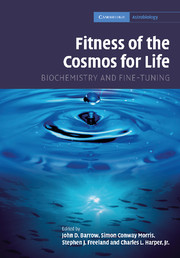Book contents
- Frontmatter
- Contents
- List of contributors
- Foreword: The improbability of life
- Preface
- Acknowledgments
- Part I The fitness of “fitness”: Henderson in context
- Part II The fitness of the cosmic environment
- Part III The fitness of the terrestrial environment
- Part IV The fitness of the chemical environment
- 16 Creating a perspective for comparing
- 17 Fine-tuning and interstellar chemistry
- 18 Framing the question of fine-tuning for intermediary metabolism
- 19 Coarse-tuning in the origin of life?
- 20 Plausible lipid-like peptides: prebiotic molecular self-assembly in water
- 21 Evolution revisited by inorganic chemists
- Index
- References
18 - Framing the question of fine-tuning for intermediary metabolism
Published online by Cambridge University Press: 18 December 2009
- Frontmatter
- Contents
- List of contributors
- Foreword: The improbability of life
- Preface
- Acknowledgments
- Part I The fitness of “fitness”: Henderson in context
- Part II The fitness of the cosmic environment
- Part III The fitness of the terrestrial environment
- Part IV The fitness of the chemical environment
- 16 Creating a perspective for comparing
- 17 Fine-tuning and interstellar chemistry
- 18 Framing the question of fine-tuning for intermediary metabolism
- 19 Coarse-tuning in the origin of life?
- 20 Plausible lipid-like peptides: prebiotic molecular self-assembly in water
- 21 Evolution revisited by inorganic chemists
- Index
- References
Summary
Learning from our own existence
Hoyle's [1] successful prediction of the 7.6 MeV resonance of the carbon-12 nucleus, based on observation of his own carbon-based existence, established the scientific usefulness of anthropic principles. These principles have become common, if not yet standard, tools in cosmology, where theories of initial conditions may not yet exist – or, if they do exist, may admit a range of values [2, 3, 4, 5, 6]. At the same time, anthropic principles have retained a traditional role in religion and philosophy, where sensitive dependence of human existence on laws of nature that could imaginably have been otherwise is interpreted as evidence for human significance in the creation of the universe.
The tendency of life forms to make universal use of, and seemingly to depend on, specific details of natural law or historical circumstance does not end with nuclear abundances. Following decades of studying the ways in which mammalian blood achieves homeostasis by exploiting favorable regions in carbonic-acid chemistry and similar adaptations, Henderson compiled a list of such dependences in physiology [7]. Inverting Darwin's description of selective fine-tuning of organisms for “fit” to their environments, Henderson characterized his physiological sensitivities anthropically as evidence of “the fitness of the environment” for life.
The rapid growth in understanding of biology, from structures to systems, seems likely to expose many more sensitivities of life to details of chemistry, physics, and history.
- Type
- Chapter
- Information
- Fitness of the Cosmos for LifeBiochemistry and Fine-Tuning, pp. 384 - 420Publisher: Cambridge University PressPrint publication year: 2007



